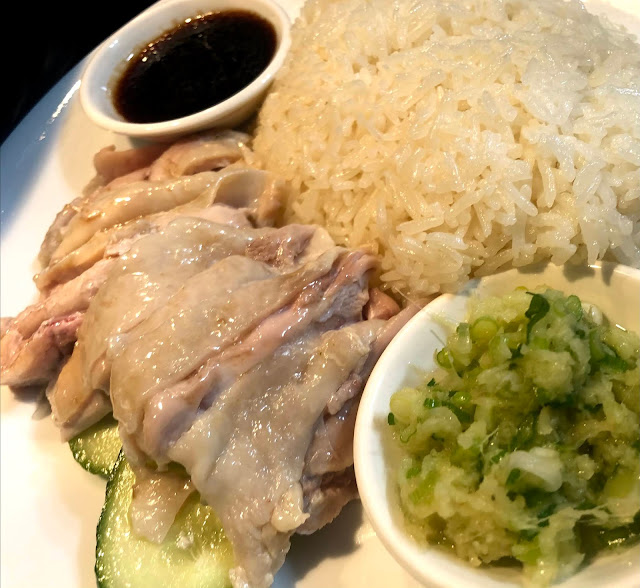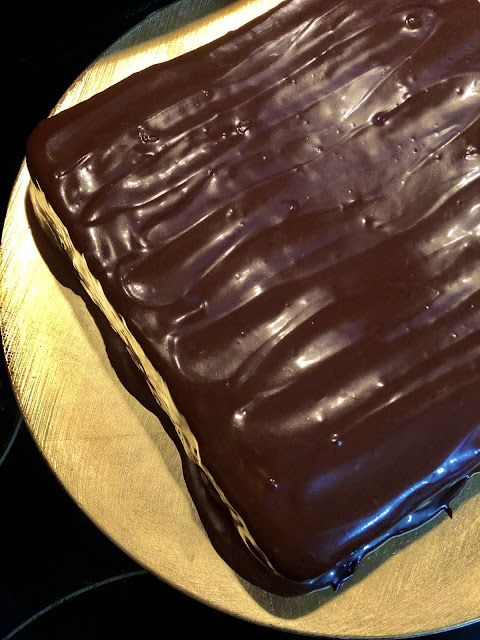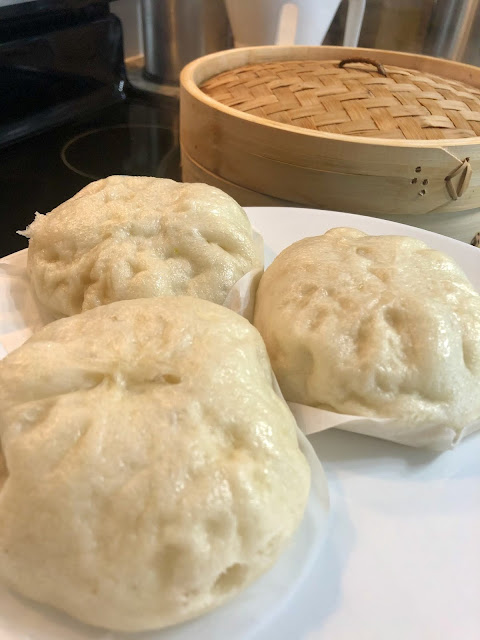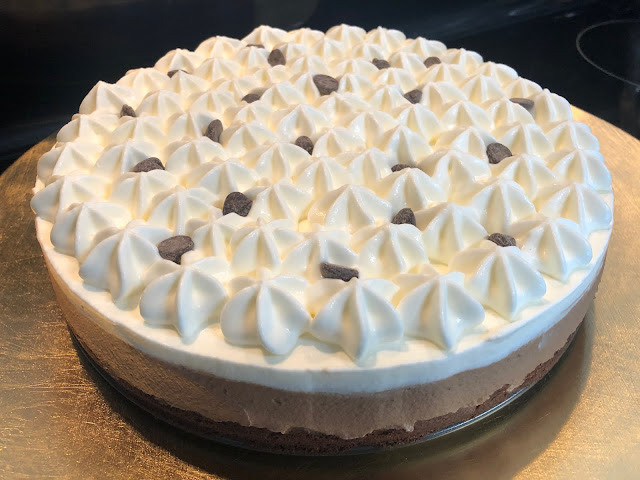Recipe: Pan-Seared Rib Eye Steak
My mouth just watered when I typed the title.
Especially now that I'm trying to type and concentrate with this beautiful piece of meat in front of me.
I used to think that getting an exquisite steak dinner required lots of moolah, a nice outfit, and a scheduled date night or birthday. Growing up in the Philippines (and I'm talking 90's to 2000's), AAA meat was expensive (well, compared to local beef and other protein sources like chicken or pork). If you wanted a good steak dinner, you had to save it for an occasion and it's best to be eaten at a 5-star hotel or a reputable restaurant. Yes, there were cheaper dining options but, well, you get what you pay for.
Rib eye steaks (or prime rib roasts) were always my choice meat when it came to steaks, beef at that. The beauty of beef is their marbling, the fat laced and intertwined in between the muscle fibres. This is the natural make-up of beef - so imagine the other breeds that don't move and get massaged too (i.e. Wagyu, Kobe, etc.). I enjoy the rib eye cut because of the caramelized fat it produces and how tender the meat is. Oh, and the surprise piece of fat in the middle (hence the name, rib eye - there's an eye of fat). This then adds so much in elevating the flavour of the steak once properly seared and cooked to your desired doneness. I like mine medium-rare. And for prime cuts like this, keep it at medium-rare. Please don't let it snooze on the pan forever until it goes to well-done. If you wanted well-done, please get another cut. Please.
You can get these cap-on (bone-in) or boneless and are mostly sliced in 1.5-inch thick portions. These rib eye steaks are found in the rib section of the cow, the first few ribs (primal rib). That's why they're so tender, they don't get much movement at all. Even if you let the cow run, this stays chill. Just imagine you as the cow - your neck, then your shoulders and upper back is the chuck, then your ribs are the ribs. Does it get much exercise?! Nope!
[Side note: Just in case you were wondering, pork IS a leaner meat than beef because the fat can be trimmed off. Notice that pork fat is on the rim of meat cuts (minus the pork belly since there's a layer of fat in between muscle strands). The problem is, we Filipinos love eating the fat too. Lechon Kawali? Or, Lechon period? With rice?!]
Anyways, rib eye steaks are easy to prepare. All you need is that glorious cut, cast iron skillet, thyme, garlic, and salt and pepper and you're set. I always top mine with a pinch of truffle salt or a drizzle of truffle oil to finish. And then I pass out.
=========================================
Pan-Seared Rib Eye Steak
Rib eye steaks (or prime rib roasts) were always my choice meat when it came to steaks, beef at that. The beauty of beef is their marbling, the fat laced and intertwined in between the muscle fibres. This is the natural make-up of beef - so imagine the other breeds that don't move and get massaged too (i.e. Wagyu, Kobe, etc.). I enjoy the rib eye cut because of the caramelized fat it produces and how tender the meat is. Oh, and the surprise piece of fat in the middle (hence the name, rib eye - there's an eye of fat). This then adds so much in elevating the flavour of the steak once properly seared and cooked to your desired doneness. I like mine medium-rare. And for prime cuts like this, keep it at medium-rare. Please don't let it snooze on the pan forever until it goes to well-done. If you wanted well-done, please get another cut. Please.
You can get these cap-on (bone-in) or boneless and are mostly sliced in 1.5-inch thick portions. These rib eye steaks are found in the rib section of the cow, the first few ribs (primal rib). That's why they're so tender, they don't get much movement at all. Even if you let the cow run, this stays chill. Just imagine you as the cow - your neck, then your shoulders and upper back is the chuck, then your ribs are the ribs. Does it get much exercise?! Nope!
[Side note: Just in case you were wondering, pork IS a leaner meat than beef because the fat can be trimmed off. Notice that pork fat is on the rim of meat cuts (minus the pork belly since there's a layer of fat in between muscle strands). The problem is, we Filipinos love eating the fat too. Lechon Kawali? Or, Lechon period? With rice?!]
Anyways, rib eye steaks are easy to prepare. All you need is that glorious cut, cast iron skillet, thyme, garlic, and salt and pepper and you're set. I always top mine with a pinch of truffle salt or a drizzle of truffle oil to finish. And then I pass out.
=========================================
Pan-Seared Rib Eye Steak
This can serve 2 portions if sliced up (like the first photo) and served with a side salad, side of fries/chips, or risotto. Or, if you don't want to share, you can have it all.
You'll need a heavy-bottom cast iron skillet, tongs, and a spoon to baste the steak. If you have a meat thermometer and need one, prepare that too.
Ingredients
250g rib eye steak, 1.5-inch thick, cap-on/bone-in (They're usually sold in 8oz slices. I personally prefer cap-on because the meat )
1 tsp salt
1 tsp pepper, freshly cracked
2 tbsp olive oil (You just want the smoking point of the oil to help sear better. Butter burns much faster because of the lactose in the butter.)
2 tbsp butter
4 cloves garlic, sliced in the middle or smashed
3-4 sprigs of thyme, fresh
Truffle salt or truffle oil to serve with
Procedure
1. Make sure your steak cut it patted dry with a paper towel. Season one side of the steak with salt and pepper.
2. Heat olive oil in the cast iron pan on medium-high heat. Just before it reaches it smoking point (starts to get hazy), add 1 tbsp of butter.
3. Sear the seasoned side of the steak on the pan.
4. Add the garlic, thyme, and butter to the pan and let it sizzle. Season the face-up side of the steak.
5. For the first 2 minutes, do not move the steak. Let it caramelize. Move the steak a bit around the pan with your tongs just so it doesn't stick to the pan and let this cook for 3 more minutes.
6. Flip the steak and let this cook for another 4 minutes (first 2 minutes, don't move it). Place the thyme and garlic pieces on top of the steak so they don't burn.
7. Now for the last minute, move the steak to one side of the pan and tilt the pan. This way, you can gather the beurre noisette (browned butter) and baste it over the steak. (Basting the flavoured butter over the steak deepens the nutty flavour and enhances the caramelization as well.)
8. If you have a meat thermometer, you can measure it at the centre-most piece of the steak. Once you reach 135℉, you've reached medium-rare. If you don't have a thermometer, you can rely on the 5 minutes per side or use any of the alternative tips below.
9. Place the steak on a chopping board or a serving plate. You'll need to be patient and rest the steak for 5 minutes. (Resting the steak allows the internal juices, that are currently boiling, to redistribute to the muscles fibres. This allows the steak to retain the juices when sliced. If you don't rest it and slice the steak right after cooking, all the juices will just seep out and will dry out the steak when you serve it.)
10. You can now serve this whole on a plate if this is intended to serve just one. If you're serving to share, carve off the bone and slice the steak against the grain, just like the first photo of this post. Drizzle the beurre noisette on top of the steak.
11. Enjoy! (Yes, this is where you finish it off with a sprinkle of truffle salt or a drizzle of truffle oil. Enjoy more!)
Storage
No advice here. Because I'm sure you'll finish it right away.
----------------------------------------
*Basting adds so much to a roast, steak, barbecue, and a lot more items. It not only deepens a flavour but also adds to the crust caramelizing. By slowly adding or basting the top of meats, it gives it time to sizzle again and again creating a more flavourful end product.
**Some prefer rosemary to thyme when cooking steaks. Fine by me, whatever floats your boat. I just prefer thyme because of its lemony-nutty-earthy and mild flavour that compliments the beurre noisette all the more. I just reserve rosemary to most chicken recipes.
***If you're not sure of the doneness and don't have a thermometer, there are other ways.
(1) One tip is that once you see blood come out of the middle of the steak, you've reached medium.
(2) Another tip is by feel, this you'll need to practice as it takes time to familiarize yourself with the feel of doneness. If you put your index finger and thumb together and pinch slightly, touch the oyster of your palm (muscle under your thumb in your palm) and that's how medium-rare feels. If you put your middle finger and thumb together, that's medium. Ring finger and thumb, that's medium-well. And pinky finger and thumb, that's well-done.
(3) If you're more comfortable with using a meat thermometer, make sure you insert the probe in the centre-most part of the steak. Also ensure you are not hitting any bone. The internal temperatures should be the following:
You'll need a heavy-bottom cast iron skillet, tongs, and a spoon to baste the steak. If you have a meat thermometer and need one, prepare that too.
Ingredients
250g rib eye steak, 1.5-inch thick, cap-on/bone-in (They're usually sold in 8oz slices. I personally prefer cap-on because the meat )
1 tsp salt
1 tsp pepper, freshly cracked
2 tbsp olive oil (You just want the smoking point of the oil to help sear better. Butter burns much faster because of the lactose in the butter.)
2 tbsp butter
4 cloves garlic, sliced in the middle or smashed
3-4 sprigs of thyme, fresh
Truffle salt or truffle oil to serve with
Procedure
1. Make sure your steak cut it patted dry with a paper towel. Season one side of the steak with salt and pepper.
2. Heat olive oil in the cast iron pan on medium-high heat. Just before it reaches it smoking point (starts to get hazy), add 1 tbsp of butter.
3. Sear the seasoned side of the steak on the pan.
4. Add the garlic, thyme, and butter to the pan and let it sizzle. Season the face-up side of the steak.
5. For the first 2 minutes, do not move the steak. Let it caramelize. Move the steak a bit around the pan with your tongs just so it doesn't stick to the pan and let this cook for 3 more minutes.
6. Flip the steak and let this cook for another 4 minutes (first 2 minutes, don't move it). Place the thyme and garlic pieces on top of the steak so they don't burn.
7. Now for the last minute, move the steak to one side of the pan and tilt the pan. This way, you can gather the beurre noisette (browned butter) and baste it over the steak. (Basting the flavoured butter over the steak deepens the nutty flavour and enhances the caramelization as well.)
8. If you have a meat thermometer, you can measure it at the centre-most piece of the steak. Once you reach 135℉, you've reached medium-rare. If you don't have a thermometer, you can rely on the 5 minutes per side or use any of the alternative tips below.
9. Place the steak on a chopping board or a serving plate. You'll need to be patient and rest the steak for 5 minutes. (Resting the steak allows the internal juices, that are currently boiling, to redistribute to the muscles fibres. This allows the steak to retain the juices when sliced. If you don't rest it and slice the steak right after cooking, all the juices will just seep out and will dry out the steak when you serve it.)
10. You can now serve this whole on a plate if this is intended to serve just one. If you're serving to share, carve off the bone and slice the steak against the grain, just like the first photo of this post. Drizzle the beurre noisette on top of the steak.
11. Enjoy! (Yes, this is where you finish it off with a sprinkle of truffle salt or a drizzle of truffle oil. Enjoy more!)
Storage
No advice here. Because I'm sure you'll finish it right away.
----------------------------------------
*Basting adds so much to a roast, steak, barbecue, and a lot more items. It not only deepens a flavour but also adds to the crust caramelizing. By slowly adding or basting the top of meats, it gives it time to sizzle again and again creating a more flavourful end product.
**Some prefer rosemary to thyme when cooking steaks. Fine by me, whatever floats your boat. I just prefer thyme because of its lemony-nutty-earthy and mild flavour that compliments the beurre noisette all the more. I just reserve rosemary to most chicken recipes.
***If you're not sure of the doneness and don't have a thermometer, there are other ways.
(1) One tip is that once you see blood come out of the middle of the steak, you've reached medium.
(2) Another tip is by feel, this you'll need to practice as it takes time to familiarize yourself with the feel of doneness. If you put your index finger and thumb together and pinch slightly, touch the oyster of your palm (muscle under your thumb in your palm) and that's how medium-rare feels. If you put your middle finger and thumb together, that's medium. Ring finger and thumb, that's medium-well. And pinky finger and thumb, that's well-done.
(3) If you're more comfortable with using a meat thermometer, make sure you insert the probe in the centre-most part of the steak. Also ensure you are not hitting any bone. The internal temperatures should be the following:
- Rare - 120-130℉
- Medium-rare - 130-135℉
- Medium - 135-145℉
- Medium-well - 145-150℉
- Well-done - 150-165℉ ("Well" will be 150-155℉)












Comments
Post a Comment